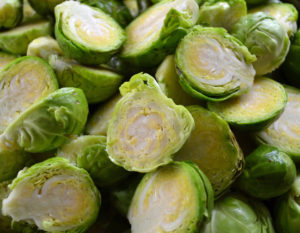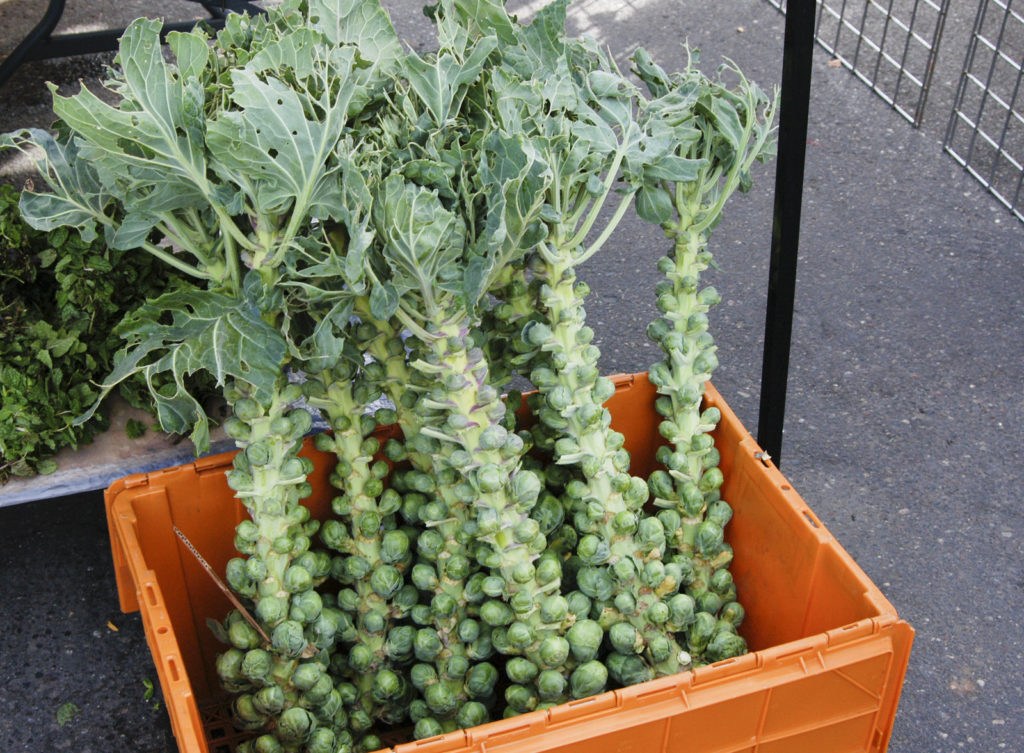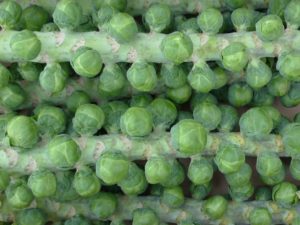A Brussels sprout is a type of wild cabbage native to the Mediterranean region and named after Brussels, Belgium. It came into popularity during the 16th century for its strong flavor and bitterness. Brussels sprouts are very healthy for you, containing high doses of vitamin A and K, and are a great source of fiber and beta-carotene. Their versatility in the kitchen makes them a favorite of many chefs. They can be steamed, boiled, roasted, sauteed, grilled, and even fried! One of the most popular ways of making Brussels sprouts is simply with butter and olive oil.
Planting Brussels Sprouts
Brussels sprouts are biennial and require full sun to grow properly. Your soil should be slightly acidic to neutral 6.0 – 7.0 pH. They grow best in growing zones 2-9, but the cooler climates may require assistance from a greenhouse or cold frame.

If starting your Brussels sprouts from seed, dig your holes half an inch deep and three inches apart. Once they start to sprout and reach a height of 6 inches, thin them until they are about two feet apart. When starting from transplants, dig container sized holes and space them two feet apart. Brussels sprouts can be grown in large containers that are 12 inches wide and deep. Also, be sure to water your Brussels sprouts well, as they are heavy drinkers and prefer moist soil.
As Brussels sprouts grow, one thing to keep in mind is they are prone to falling over from strong wind. If you live in a windy area, it is highly recommended you stake each plant to give it extra support from harsh winds. There are some varieties that grow more compact, like Jade Cross, that will not require staking.
Once planted, Brussels sprouts take on average 90 to 100 days until they are ready for harvest. While planting, one essential nutrient Brussels sprouts need is boron. Adding boron to your soil is easy. Purchase some Borax and combine 1 teaspoon with a gallon of water then spray around 100 square feet. Don’t worry about the Borax damaging your soil because boron is a naturally occurring chemical. Organic liquid fertilizers and nutrient rich compost will also help your Brussels sprouts grow.
When To Harvest Brussels Sprouts
Brussels sprouts can reach a height of 2 to 3 feet tall and should be harvested from the bottom up. When each sprout reaches a diameter of 1 inch is when you should harvest them. After picking your sprouts they should not be washed until right before cooking. If all the sprouts are mature, you can pull the entire stalk from the ground, and it should last approximately 1 month in a cool basement.

Brussels Sprouts Pests and Diseases
One downside to growing Brussels sprouts is they are prone to many disease and pest problems. Below you will find a list of all the common ailments your Brussels sprouts may encounter.
Aphids are tiny insects that leave behind a sticky honeydew excrement and sooty black mold. They like to collect under the leaves of the Brussels sprouts and will cause the leaves to curl. Manage aphids with insecticidal soaps, banana and orange peels around the base of the plant, or by planting native flowers that invite predatory insects like ladybugs to eat them.

Black rot is frustrating because other than throwing out the plant, there is not much you can do. Planting diseases resistant varieties and making sure you soil is properly drained should help minimize the chance of black rot afflicting your plants. This fungus will cause the leaves to turn yellow and the veins to turn black.
Cabbage loopers and cabbageworms are types of caterpillars that will munch on your Brussels sprouts leaves and leave jagged holes. Utilizing an insecticidal soap and handpick removing these from your plants should help. Row covers can also be used.
Cabbage root maggots are difficult to detect because they feed on the roots in the soil. A sign of cabbage root maggots is stunted growth. Row covers and creating a ring of diatomaceous earth around the base of the plant should help.
Clubroot is a type of fungus that will cause your Brussels Sprouts to appear wilted, stunted, yellowish, and with swollen roots. As with most fungus, preventative care is key. If your Brussels sprouts are infected with clubroot, they will need to be destroyed and your crops will need to be rotated.
Downy mildew is a fungus that will leave yellowish fluffy patches on the leaves. A copper-based fungicide should help kill off this fungus.
Flea beetles will chew and create numerous tiny holes on the leaves of your plants. Heavy mulching and planting native plants that will invite predatory insects should help mitigate flea beetles.
White mold creates a pale greyish cottony growth on the leaves. The plants will eventually develop black particles then wither and die. With white mold all you can do is destroy the plant, disinfect your tools, remove any existing crop residue, and rotate your crops.
Starting a Brussels Sprouts Garden
Starting to plant Brussels sprouts is easy if you employ the help of a garden planner that reminds you of when it is time to sow, grow, and harvest. Garden Savvy’s Hortisketch is a tool savvy gardeners utilize to rotate their crops and plan their gardens each season. Ensure your Brussels sprouts are a success this year and try planning your garden with Hortisketch.

Contact Author
 info@gardensavvy.com
info@gardensavvy.com Recent Posts
- Smart Gardening: How Technology Is Revolutionizing Horticulture
- Understanding Gardening Zones: What You Need to Know
- The Right Tools For Your Gardening And Landscaping Needs
- Maximizing Your Harvest: Square Foot Gardening Chart for Beginners
- Holiday Garden Scents: Plants for Natural Aromatherapy in Your Home









